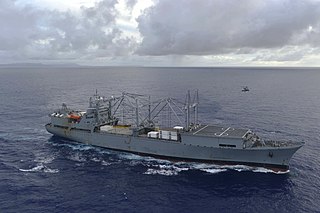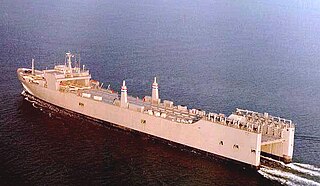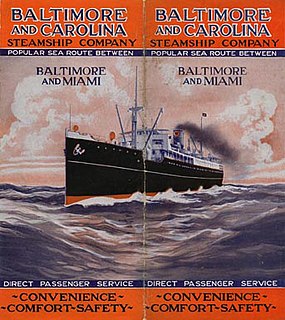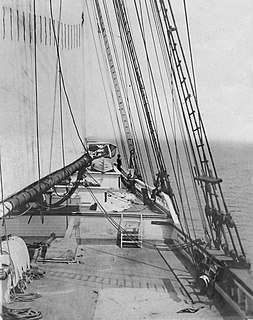
Liberty ships were a class of cargo ship built in the United States during World War II under the Emergency Shipbuilding Program. Though British in concept, the design was adopted by the United States for its simple, low-cost construction. Mass-produced on an unprecedented scale, the Liberty ship came to symbolize U.S. wartime industrial output.

Bethlehem Steel Corporation Shipbuilding Division was created in 1905 when the Bethlehem Steel Corporation of Bethlehem, Pennsylvania, acquired the San Francisco shipyard Union Iron Works. In 1917 it was incorporated as Bethlehem Shipbuilding Corporation, Limited.

Fore River Shipyard was a shipyard owned by General Dynamics Corporation located on Weymouth Fore River in Braintree and Quincy, Massachusetts. It began operations in 1883 in Braintree, and moved to its final location on Quincy Point in 1901. In 1913, it was purchased by Bethlehem Steel, and later transferred to Bethlehem Shipbuilding Corporation. It was sold to General Dynamics in 1963, and closed in 1986. During its operation, yardworkers constructed hundreds of ships, for both military and civilian clients.
SS Robert E. Peary was a Liberty ship which gained fame during World War II for being built in a shorter time than any other such vessel. Named after Robert Peary, an American explorer who was among the first people to reach the geographic North Pole, she was launched on November 12, 1942, just 4 days, 15 hours and 29 minutes after the keel was laid down.

SS Patrick Henry was the first Liberty ship launched. It was built by the Bethlehem Shipbuilding Corporation at their Bethlehem-Fairfield Shipyard in Baltimore, Maryland. She was named after Patrick Henry, an American attorney, planter, and Founding Father as well as the first and sixth post-colonial Governor of Virginia, from 1776 to 1779 and 1784 to 1786.
Maryland Steel, in Sparrows Point, Maryland, US, was founded in 1887. It was acquired by Bethlehem Shipbuilding Corporation in 1916 and renamed as the Bethlehem Sparrows Point Shipyard. The shipyard was sold in 1997 to Baltimore Marine Industries Inc.. In 2012, it was owned by Barletta Industries, which had converted it to the Sparrows Point Shipyard and Industrial Complex. As of 2021, it is owned by Sparrows Point Terminal, LLC and has been renamed Tradepoint Atlantic.

The Federal Shipbuilding and Drydock Company was a United States shipyard, active from 1917 to 1948. It was founded during World War I to build ships for the United States Shipping Board. During World War II, it built ships as part of the U.S. Government's Emergency Shipbuilding program. Operated by a subsidiary of the United States Steel Corporation, the shipyard was located at Kearny Point where the mouth of the Hackensack River meets Newark Bay in the Port of New York and New Jersey. The shipyard site is now part of River Terminal, a massive distribution facility that is partially a foreign trade zone.

The Emergency Shipbuilding Program was a United States government effort to quickly build simple cargo ships to carry troops and materiel to allies and foreign theatres during World War II. Run by the U.S. Maritime Commission, the program built almost 6,000 ships.

The Bethlehem-Fairfield Shipyard of Baltimore, Maryland, was a shipyard in the United States from 1941 until 1945. Located on the south shore of the Middle Branch of the Patapsco River which serves as the Baltimore Harbor, it was owned by the Bethlehem Shipbuilding Company, created by the Bethlehem Steel Corporation of Bethlehem, Pennsylvania, which had operated a major waterfront steel mill outside Baltimore to the southeast at Sparrows Point, Maryland in rural Baltimore County since the 1880s.

The Type C4-class ship were the largest cargo ships built by the United States Maritime Commission (MARCOM) during World War II. The design was originally developed for the American-Hawaiian Lines in 1941, but in late 1941 the plans were taken over by the MARCOM.

The Type C5 ship is a United States Maritime Administration (MARAD) designation for World War II breakbulk cargo and later a container ship for containerization shipments. The first type C5-class ship was a class of ships constructed and produced in the United States during World War II. The World War II C5-class ship was dry bulk cargo ship built by Bethlehem Steel in Sparrows Point, Maryland. Bethlehem Steel built eight ships in this bulk cargo class and four orders were canceled. The C5-class ship has a 24,250 DWT and was 560 feet (170 m) long. The C5 was mainly used as iron ore carriers. The C5 was needed to replace other ships that sank during World War II. First in her class was SS Venore, USMC #1982, delivered on 20 July 1945. The Type C5-class ship designed to fill the need to move iron ore from Santa Cruz, Chile, to Sparrows Point, Maryland, through the Panama Canal, a round-trip of 8,700 nautical miles . Post World War II, four ships were given C5 class type C5-S-78a, these were roll-on/roll-off container ship built by Ingalls Shipbuilding, Inc. of Pascagoula, Mississippi and operated by the Moore-McCormack Lines. The C5-S-78a had a deadweight tonnage of 16,000 tons.

SS Georgetown Victory was a Victory ship built for the War Shipping Administration late in World War II under the Emergency Shipbuilding program. She was a type VC2-S-AP2/WSAT cargo ship with the United States Maritime Commission (MCV) -"Victory"; hull number 653, shipyard number 1597 and built by Bethlehem Shipbuilding Corporation in Baltimore, Maryland, she was laid down on 8 March 1945. Georgetown Victory, named after Georgetown University, was launched from the Bethlehem-Fairfield shipyard at Baltimore on April 28, 1945 and completed on 22 May 1945.

Type C8-class ships are a type of Heavy Lift Barge Carrier. Type C8 ships were the 8th type of ship designed by the United States Maritime Commission (MARCOM) in the late 1960s. As done with the Type C1 ships and Type C2 ships, MARCOM circulated preliminary plans for comment. The design presented was not specific to any service or trade route. Type C8 ships measuring 876 feet (267 m) from stem to stern, and designed to make 16.2 knots.
SS St. Olaf was a Liberty ship built in the United States during World War II. She was named after St. Olaf, the King of Norway from 1015 to 1028. He was posthumously given the title Rex Perpetuus Norvegiae and canonised at Nidaros, by Bishop Grimkell, one year after his death in the Battle of Stiklestad.
SS William Patterson was a Liberty ship built in the United States during World War II. She was named after William Patterson, a businessman, a gun-runner during the American Revolution, and a founder of the Baltimore and Ohio Railroad.
Pacific Far East Line, also called PFEL in short, was a passenger and cargo shipping line founded in 1943 by Thomas E. Cuffe, in San Francisco, California. At the beginning he started by chartering foreign ships to run the lines in tramp trade. Later scheduled cargo services were added to the line. During World War II the South Atlantic steamship line was active with charter shipping with the Maritime Commission and War Shipping Administration.

A. H. Bull Steamship Company was a shipping company and passenger liner service founded in New York City in 1902 by Archibald H. Bull (1848-1920). Service started with shipping between New York and Florida. His fleet of ships then added service to other Eastcoast ports. The company is also often called the Bull Lines and the Bull Steamship Line or A. H. Bull & Company. While founded in New York, Bull soon move its headquarter to Peir 5 in Baltimore, Maryland. Bull Lines main Eastcoast ports were: Baltimore, Charleston, Philadelphia, Tampa and Norfolk, Virginia. Oversea ports: Porto Rico, Antwerp, Bordeaux, Hamburg, Bremen, Copenhagen, and West Africa. Bull Steamship Line supported the US war effort for both World War I and World War II, including the loss of ships.

Bethlehem Key Highway Shipyard started as William Skinner & Sons in downtown Baltimore, Maryland in 1815. In 1899 the shipyard was renamed Skinner Shipbuilding & Dry Dock Company. Also at the site was Malster & Reanie started in 1870 by William T. Malster (1843–1907). In 1879 Malster partnered with William B. Reaney (1808-1883). In 1880 Malster & Reanie was sold and renamed Columbian Iron Works & Dry Dock Company. Malster & Reanie and Skinner Shipbuilding & Dry Dock Company merged in 1906, but remained as Skinner Shipbuilding. In 1914 the company was renamed Baltimore Dry Dock & Shipbuilding Company. Baltimore Dry Dock & Shipbuilding Company sold to Bethlehem Steel in 1922, becoming part of Bethlehem Shipbuilding Corporation. Bethlehem Steel operated the shipyard for ship repair, conversion and some ship construction. Bethlehem main ship construction site was across the harbor at Bethlehem Sparrows Point. Bethlehem Key Highway Shipyard was known as the Bethlehem Upper Yard located north-east side of Federal Hill. Bethlehem Fort McHenry Shipyard located on the west side of Locust Point peninsula was known as the Lower Yard, near Fort McHenry.

World War II United States Merchant Navy was the largest civilian Navy in the world, which operated during World War II. With the United States fighting a world war in all the world oceans, the demand for cargo and fuel was very high. Cargo and fuel was needed around the world for the United States Navy, United States Army, United States Marine Corps, United States Army Air Forces, United States Coast Guard and the support of the allied nations of the United States. American steamship companies chartered ships from the Maritime Commission and War Shipping Administration to meet the demand. Many United States Merchant Marine ships were newly built in the Emergency Shipbuilding Program, other ships were older World War I ships that were put back in service, or private ships acquired under Emergency war requisitions. The Merchant Navy operated in the Pacific War and European war. Over 200 US Merchant ships took part in the D-day Normandy landings. To make a Normandy breakwater Harbor, called Mulberry harbour, 33 merchant ships were sunk 1,000 yards from shore. Some of the ghosts merchant ships used were damaged and others were deemed too old.

Wilmore Steamship Company was a steamship shipping company that was founded in New York City in 1930. The Wilmore Steamship Company mainly operated coal ships, called Collier ship. The coal ships main routes were loading coal at Hampton Roads, Virginia, and delivering the coal to New England ports. The first two ships on the on the route were the SS Berwindglen and SS Berwindvale. Both ships were built by Bethlehem Steel's Bethlehem Shipbuilding Corporation at Quincy, Massachusetts, at the Fore River Shipyard. SS Berwindglen and SS Berwindvale were new 4,411-ton colliers ships, that had first United States engines that used pulverized coal-fired boilers. The steamship SS Mercer, a 9,500 ton merchant ship was the test ship of pulverized coal, modified to evaluated pulverized coal in 1929. The test were good and the SS Berwindglen and SS Berwindvale were built for this new fuel. Wilmore Steamship Company was named after Wilmore Heights, Pennsylvania. Wilmore Steamship Company was active in supporting the World War II effort.















